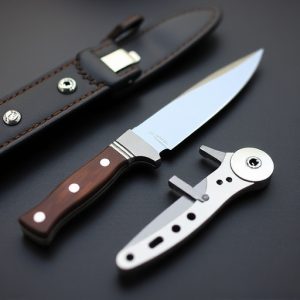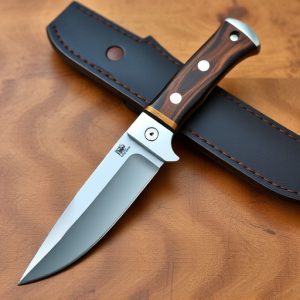Choosing and Maintaining the Ideal Fixed Blade Knife for Bushcraft Enthusiasts
When selecting a fixed blade knife for bushcraft from those available for purchase, it's crucia…….
When selecting a fixed blade knife for bushcraft from those available for purchase, it's crucial to prioritize high-grade steel like CPM S30V, CPM S35VN, or VG-10 for durability and performance. These steels offer excellent edge retention and corrosion resistance, which are essential for the demands of outdoor survival tasks. The blade's thickness, shape, spine robustness, and belly definition should be tailored to your specific tasks, whether you're carving or batoning. An ergonomic handle that complements your hand size is vital for comfort and control during extended use. It should also be weather-resistant, with options like micarta, wood, or G10 providing a secure and comfortable grip in all conditions. The blade length must be suitable for your intended use, offering a balance between leverage and maneuverability. A high-quality sheath is necessary for protection when not in use and for easy carry. Proper maintenance involves regular cleaning, sharpening with coarse and fine stones at a 15 to 20-degree angle per side, and applying protective oil to preserve the knife's condition. Mastery of the knife extends beyond physical upkeep; it requires understanding its full potential and effectively utilizing various techniques for bushcraft activities like fire starting, food preparation, and tool creation. A well-chosen fixed blade knife, combined with skillful application, ensures efficient and safe navigation of natural environments for both novices and experienced outdoorsmen.
Explore the world of bushcraft with an emphasis on fixed blade knives, essential tools for outdoor enthusiasts and survivalists. This article delves into the intricacies of selecting the ideal knife from the myriad of fixed blade knives for sale, focusing on material quality, key features, and maintenance tips to ensure your knife stands up to the demands of nature. From the art of sharpening to mastering techniques in diverse bushcraft scenarios, gain insights that will transform your next wilderness adventure.
Understanding Fixed Blade Knives: The Essence of Bushcraft Tools
Fixed blade knives are an indispensable tool in the practice of bushcraft, serving as a cornerstone in survival scenarios and outdoor expeditions. Their robust design and durability make them suitable for a myriad of tasks, from fine carving to heavy-duty batching. When selecting a fixed blade knife for sale, consider the blade’s material, shape, and length, as these factors will influence its performance and suitability for various activities. High-quality steel ensures longevity and resistance to wear, while an ergonomically designed handle enhances comfort during prolonged use. The full tang construction of a fixed blade knife provides strength and stability, ensuring it can withstand the demands of outdoor living without failure.
In the realm of bushcraft, the fixed blade knife’s simplicity and reliability set it apart from its folding counterparts. Its straightforward operation and maintenance-free design mean that users can rely on it in environments where conditions are less than ideal. The knife’s versatility is matched by its ability to be expertly sharpened in the field, allowing for precise cuts every time. For those venturing into the wilderness or honing survival skills, a fixed blade knife from reputable sellers is an investment in safety and efficiency. It is a tool that not only complements the skillset of seasoned bushcrafters but also empowers beginners to take their first steps towards mastery of traditional outdoor crafts.
Key Features to Look for in Fixed Blade Knives for Sale
When in the market for a reliable fixed blade knife, several key features should be at the forefront of your evaluation. Firstly, consider the blade material, with high-carbon steel being a popular choice due to its durability and ability to hold an edge well. The blade’s thickness and shape are also crucial; a robust spine and a belly that suits the tasks you intend to use it for, like carving or batoning, will enhance functionality in various bushcraft scenarios.
The handle ergonomics cannot be overstated; a secure grip ensures control and comfort during prolonged use. Look for a handle that fits your hand well, allowing for a solid connection between the user and the knife. Additionally, the overall length of the blade should align with your intended use case; a longer blade may offer more leverage but could be less maneuverable in tight spaces. A fixed blade knife for sale that comes with a sturdy sheath or protective cover is equally important, as it will safeguard the blade when not in use and facilitate easy carrying in a variety of environments. Always ensure the knife you choose is made with quality craftsmanship and materials to guarantee its performance under the demanding conditions often encountered in bushcraft situations. Shopping for fixed blade knives for sale with these considerations in mind will help you find an instrument that’s up to the task, whether you’re a seasoned outdoorsman or just beginning your journey into the world of bushcraft.
Material Matters: Selecting the Right Steel and Handle for Your Fixed Blade
When venturing into the realm of bushcraft, the choice of a fixed blade knife can be as critical as the skills wielded with it. The steel from which the blade is forged plays an indispensable role in determining its performance and longevity in various conditions. High-quality stainless steels like CPM S30V, CPM S35VN, and VG-10 are highly regarded in the bushcraft community for their ability to hold an edge, resist corrosion, and perform under harsh environments. These steels offer a balance between toughness and sharpness, which is essential for tasks ranging from batoning to fine carving. When browsing fixed blade knives for sale, consider steels like these for their proven track record in outdoor survival scenarios.
Equally important as the steel is the handle material, which should complement the user’s grip and durability needs. Handles can be made from a variety of materials including micarta, wood, and G10, each with its own advantages. Micarta offers a blend of strength and comfort, withstanding moisture without swelling or losing shape. Wooden handles add an element of traditional craftsmanship and can provide a more organic feel. G10 is known for its resilience against the elements and is often chosen for its non-slip properties even when wet. When selecting a handle, consider how the knife will be used, the frequency of use, and personal hand size and grip strength to ensure a secure and comfortable hold in all conditions. Quality fixed blade knives with ergonomic handles are readily available for purchase, ensuring that your investment remains reliable and efficient throughout your bushcraft endeavors.
The Art of Sharpening and Maintaining Your Bushcraft Fixed Blade Knife
When venturing into the realm of bushcraft, maintaining a reliable and sharp fixed blade knife is paramount. A fixed blade knife, as opposed to its folding counterparts, offers unparalleled durability and strength, making it an essential tool for tasks ranging from batoning wood to precision carving. To ensure your bushcraft fixed blade remains in optimal condition, regular maintenance is a necessity, not an option. Begin by inspecting the edge for nicks or rolls that can impair its cutting efficiency. Use a combination of coarse and fine sharpening stones to restore the edge, maintaining a consistent angle throughout the process—typically between 15 to 20 degrees per side—to avoid over-sharpening and weakening the blade.
For those looking for fixed blade knives for sale, consider factors such as the steel composition, which affects both hardness and resilience against corrosion; the handle material, which should provide a secure and comfortable grip even when hands are wet or covered in sap; and the overall length, which must suit your intended tasks. After purchase, apply a thin layer of oil to the blade and wipe clean after each use to protect it from rust and to maintain its sharpness. Regularly sharpening your bushcraft fixed blade knife not only prolongs its lifespan but also enhances your safety and effectiveness in any outdoor situation.
Mastering Techniques: Using Your Fixed Blade Knife in Various Bushcraft Scenarios
When venturing into the wilderness, a fixed blade knife is an indispensable tool for any bushcraft enthusiast. These robust knives are designed to withstand the rigors of outdoor survival and are ideal for a multitude of tasks from batoning through dense wood to carving intricate items. Mastery of your fixed blade knife is not just about sharpness; it’s about understanding its capabilities and limitations, and how it can be best utilized in diverse bushcraft scenarios.
A fixed blade knife for sale should be chosen with care, considering the steel type, handle ergonomics, and overall length that suits your hand and intended use. The blade’s edge must be keen enough to shave hair but durable to split wood without chipping. In practice, you’ll need to employ different techniques: from feather sticking to notching for shelters, the fixed blade is your constant companion. Skillfully using a fire steel alongside your knife can provide warmth and light, essential for signaling or simply comfort during chilly nights. Whether you’re preparing food, creating tools, or fashioning shelter components, each task demands a specific approach to ensure both efficiency and safety. Those who invest in high-quality fixed blade knives for sale and dedicate time to honing their skills will find these tools can make the difference between thriving in the wilderness or facing challenges with difficulty. The versatility of a fixed blade knife, when paired with the right knowledge and technique, becomes a testament to human adaptability and ingenuity in the natural world.


